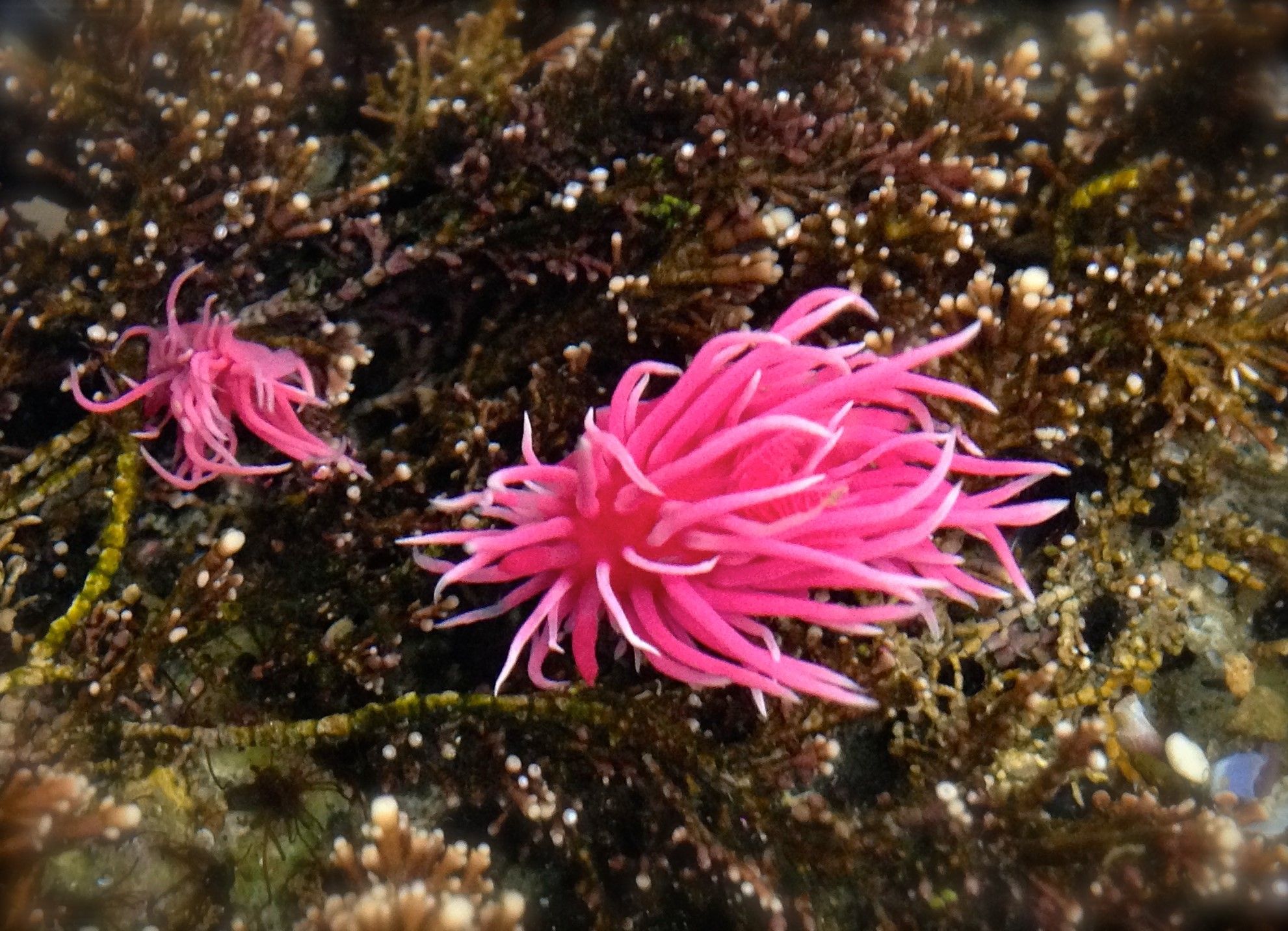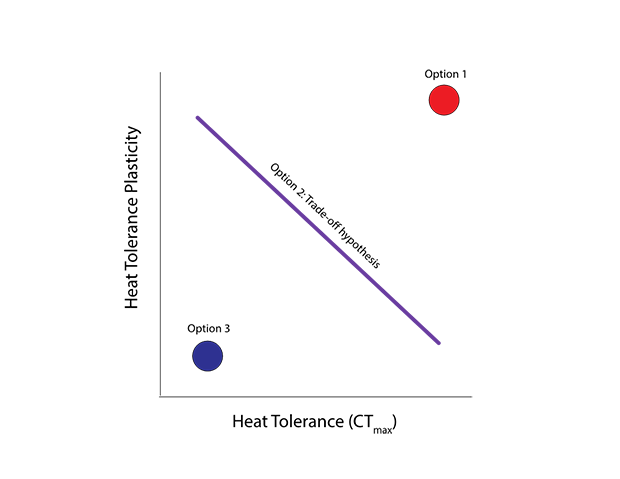Sea Slugs Make Climate Evolutionary Choices

Nudibranchs are a type of sea slug known for their beautiful colors and curious incorporation of other animals and plants into their own bodies (e.g. using plant chloroplasts to photosynthesize, incorporating toxins into their cells, and swallowing anemones’ stinging cells whole to place in their own tentacles). But did you know they also have more nuanced advantages in their habitats, most importantly under climate change scenarios: they appear to be incredibly heat tolerant. Nudibranchs are mollusks, which you may recognize as being mostly shelled animals like clams, snails, and oysters. But nudibranchs have lost their shells over evolutionary time, and still inhabit areas that are exposed to extreme environmental conditions (like in the rocky intertidal zone). They can’t swim away, have no shell, and still survive every tidal cycle (where they get exposed to the hot sun and air for hours at a time!) like it’s no big deal.
Researcher Dr. Eric Armstrong and I started seeing dozens (that’s a lot!) of nudibranchs on the shores around the San Francisco Bay Area in California in Spring 2016. It was an El Nińo year, which seems to cultivate lots of baby nudibranchs on the shores of the west coast of America, for reasons still unknown1. One important thing to note is that El Nińo years bring warmer waters to our coast. We knew we had to document the heat tolerance of as many species of nudibranchs as possible and attempt to understand how they accomplished such a feat as individual species and as a group.

From left to right: (A) Doriopsilla spp. in the heat tolerance test (B) Triopha catalinae being measured before tests, and (C) Okenia rosacea at Avila Beach, CA during a collection. All photo credits: R. Tanner.
Heat tolerance can be measured a couple of different ways, and they each tell a different part of the whole story. We chose to focus on the critical thermal maximum limit and the plasticity of this limit with different environmental conditions (or how easily these limits can be manipulated in the lab with temperature acclimation). The critical thermal maximum, or CTmax, tells us what temperature a nudibranch can withstand for a short period of time. We measure it by rapidly increasing the water temperature for a single nudibranch, and observing when it lost muscle function. After losing muscle function, a nudibranch is unable to hold on to its rock or leaf blade, and therefore cannot perform its function in the habitat. It’s important to note that they are not dead at this point! When returned to cooler temperatures, they recover just fine. Therefore, this is the maximum temperature at which a nudibranch can survive for short periods of time. The plasticity of CTmax tells us something a little more interesting about how a nudibranch can change its heat tolerance with long-term warming. We measure it by keeping nudibranchs at multiple different temperatures in the lab for at least two weeks, and then comparing their CTmax values after those acclimation periods. High plasticity means that a nudibranch can increase its CTmax with warmer acclimation. Low plasticity means CTmax isn’t affected by acclimation temperature.
With human-induced climate change, we can expect to see an increase in the number of extreme temperatures and the average temperature of the environment2 more rapidly than organisms are accustomed to. This means that both plasticity and CTmax are important measures of how species will survive under climate change3. There are a few options: high plasticity and CTmax, low plasticity and high CTmax (or vice versa), and low plasticity and CTmax. The first option is most ideal under climate change – being able to adjust upper temperature limits that are already high would protect a species from both consequences of climate change. However, this is energetically costly to maintain! They might not have enough energy left to reproduce. The third option will most likely result in extinction, since the species has little ability to adapt on a rapid time scale. The middle option is often referred to as the “Trade-Off Hypothesis”. Other intertidal animals like porcelain crabs show this pattern as well4. If a nudibranch has high CTmax, it will have little ability to change it – but that could be ok if the limit is already higher than projected climate extremes. If a nudibranch has low CTmax, it will be able to change it rapidly with warming temperatures, but it may not survive extremes if CTmax is inherently lower than the upper limit of environmental temperatures.

Responses to climate change in two heat tolerance traits: CTmax and plasticity. Graphic by R. Tanner.
Nudibranchs follow the Trade-Off Hypothesis in a latitudinal pattern. This means that more southern populations have reduced plasticity but higher CTmax, and more northern populations have high plasticity but lower CTmax5. We see this pattern along the nudibranch lineage in multiple species. This is very cool! Since nudibranchs disperse far and wide along the coast as babies, they have evolved the ability to trade off between these two types of heat tolerance based on where they end up settling as adults. Unfortunately, climate change throws a wrench in this pattern – warming patterns put southern populations at more of a risk, since they are unable to increase their CTmax limits any further with warmer average temperatures.
This study was just the beginning for researchers looking at the physiology of temperate (i.e. neither tropical nor polar) nudibranchs. But there is so much more to learn – mollusks are one of the most diverse and largest taxonomic groups on Earth, and fast growing. With more knowledge, we may be able to use nudibranchs as indicators of ecosystem health under climate change scenarios. Want to help researchers meet this goal? Sign up for iNaturalist and get your friends on board for a nature walk, where you can document all types of ocean and land indicator species and be a part of our mission to understand and protect our changing world.
- Schultz, S. T. et al. Climate-index response profiling indicates larval transport is driving population fluctuations in nudibranch gastropods from the northeast Pacific Ocean. Limnol. Oceanogr. 56, 749 (2011).
- IPCC. Climate Change 2014: Impacts, Adaptation, and Vulnerability. Part A: Global and Sectoral Aspects. Contribution of Working Group II to the Fifth Assessment Report of the Intergovernmental Panel on Climate Change [Field, C.B., V.R. Barros, D.J. Dokken, K.J. Mach, M.D. Mastrandrea, T.E. Bilir, M. Chatterjee, K.L. Ebi, Y.O. Estrada, R.C. Genova, B. Girma, E.S. Kissel, A.N. Levy, S. MacCracken, P.R. Mastrandrea, and L.L. White (eds.)]. (Cambridge University Press, 2014).
- Gunderson, A. R. & Stillman, J. H. Plasticity in thermal tolerance has limited potential to buffer ectotherms from global warming. Proc. R. Soc. B Biol. Sci. 282, (2015).
- Stillman, J. H. Acclimation Capacity Underlies Susceptibility to Climate Change. Science 301, 65–65 (2003).
- Armstrong, E. J., Tanner, R. L. & Stillman, J. H. High Heat Tolerance Is Negatively Correlated with Heat Tolerance Plasticity in Nudibranch Mollusks. Physiol. Biochem. Zool. 92, 430–444 (2019).
About the Author:
Dr. Richelle Tanner is a Postdoctoral Research Associate at Washington State University, specializing in marine evolutionary and environmental physiology, climate change effects, and bioinformatics. She also serves as chair of the Science Partnerships Committee of the National Network for Ocean and Climate Change Interpretation.
The original article can be found at https://www.journals.uchicago.edu/doi/abs/10.1086/704519?journalCode=pbz. Request for a copy for the article may be sent to (richelle.tanner@richelletanner.com) or: https://www.researchgate.net/publication/333182660_High_heat_tolerance_is_negatively_correlated_with_heat_tolerance_plasticity_in_nudibranch_molluscs
More Blog Posts
 We Need a Sea Change in How We Communicate about Ocean Change. Metaphors Can Help.We Need a Sea Change in How We Communicate about Ocean Change. Metaphors Can Help. October 28 2016 This is the fourth post in a series about framing ocean and climate change. We depend on our oceans and must protect them, yet they are often overlooked in public conversations about “climate change.” As a result, most people don’t understand how [READ MORE]
We Need a Sea Change in How We Communicate about Ocean Change. Metaphors Can Help.We Need a Sea Change in How We Communicate about Ocean Change. Metaphors Can Help. October 28 2016 This is the fourth post in a series about framing ocean and climate change. We depend on our oceans and must protect them, yet they are often overlooked in public conversations about “climate change.” As a result, most people don’t understand how [READ MORE] Thinking Bigger On SolutionsThinking Bigger On Solutions by Allison Arteaga, February 28 2020 We all know that we need big, systems-level change in our society in order to address climate change and create a better future. This requires high-impact collective actions that create change at the cultural and public levels by bringing people together (Frameworks). The challenge [READ MORE]
Thinking Bigger On SolutionsThinking Bigger On Solutions by Allison Arteaga, February 28 2020 We all know that we need big, systems-level change in our society in order to address climate change and create a better future. This requires high-impact collective actions that create change at the cultural and public levels by bringing people together (Frameworks). The challenge [READ MORE] A Scientist’s Take On Communication TrainingA Scientist’s Take On Communication Training By Evelyn Beaury, August 27 2019 My lessons learned from NNOCCI’s keys to successful climate change conversations – let’s solve this together! With such a polarizing, politicized, and frightening subject, it’s easy to slide into contentious conversation when talking about climate change. I [READ MORE]
A Scientist’s Take On Communication TrainingA Scientist’s Take On Communication Training By Evelyn Beaury, August 27 2019 My lessons learned from NNOCCI’s keys to successful climate change conversations – let’s solve this together! With such a polarizing, politicized, and frightening subject, it’s easy to slide into contentious conversation when talking about climate change. I [READ MORE] My Community is My Hope #100HopefulDaysMy Community is My Hope #100HopefulDays Sarah-Mae Nelson, MS, CIG/CIT, February 03 2017 Today I turn 37 years old. This seems like an impossible number. In my mind, I am a vibrant 21-year-old eager to make the world a better place. I see opportunities to make a positive difference everywhere. I am young, I am empowered, and I am unstoppable. In [READ MORE]
My Community is My Hope #100HopefulDaysMy Community is My Hope #100HopefulDays Sarah-Mae Nelson, MS, CIG/CIT, February 03 2017 Today I turn 37 years old. This seems like an impossible number. In my mind, I am a vibrant 21-year-old eager to make the world a better place. I see opportunities to make a positive difference everywhere. I am young, I am empowered, and I am unstoppable. In [READ MORE] Communicating in the Swamp: How to Navigate Public Thinking About Climate and Ocean ChangeCommunicating in the Swamp: How to Navigate Public Thinking About Climate and Ocean Change July 22 2016 This is the first in a series about framing ocean and climate change. When people think about oceans this summer, they might think of a good vacation spot—a place to spread out the beach towel, pop up the umbrella, and relax under the sun as [READ MORE]
Communicating in the Swamp: How to Navigate Public Thinking About Climate and Ocean ChangeCommunicating in the Swamp: How to Navigate Public Thinking About Climate and Ocean Change July 22 2016 This is the first in a series about framing ocean and climate change. When people think about oceans this summer, they might think of a good vacation spot—a place to spread out the beach towel, pop up the umbrella, and relax under the sun as [READ MORE]